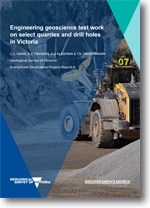EGPR 6 - Engineering geoscience test work on select quarries and drill holes in Victoria.
 |
| |||||||||||||||||||||||||||||||||||||||||||
Product description:Executive Summary:Engineering geoscience test work data is fundamental to understanding the types of construction products that can be produced from different source rocks. As part of building a geoscience evidence base for extractive resources in the state, the Geological Survey of Victoria sampled a variety of source rocks and construction products from greater Melbourne and surrounds, comprising: • 61 samples from 44 legacy diamond drill holes. • 80 samples from 26 active quarry operations. A mix of raw source rock and quarry products were sampled. The most common source rock sampled was basalt of the Newer Volcanic Group, followed by (natural) sand from several stratigraphic units. In addition, representative samples of granite, granodiorite, rhyodacite, hornfels and gravel were also collected. Engineering geoscience test work was completed for 130 samples to evaluate durability and performance as construction products. Degradation factor, aggregate soundness and wet and dry strength were used to assess the durability of hard rock samples. The highest degradation factor results were associated with granite and hornfels samples, exceeding values for specification requirements. There was a general trend of decreasing degradation factor and increasing wet and dry strength variation with increasing water absorption. Additionally, for all source rock types, there was a general increase in variation between wet and dry strength results as wet strength decreased. An increase in the total weighted loss of a sample with increasing water absorption has demonstrated a relationship between aggregate soundness and water absorption. Rhyodacite, granodiorite and hornfels quarry product samples were found to have the lowest aggregate soundness values, however some basalt (drill core) samples also returned comparatively low aggregate soundness values. Particle size distribution and clay and fine silt testing was undertaken on natural sand, manufactured sand and unspecified quarry dust samples. Natural sand had a higher proportion of material passing through 2.36 mm and 1.18 mm size fractions compared to manufactured sand, whilst manufactured sand had a higher proportion of material finer than 0.075 mm compared to natural sand. The average curves for all manufactured sand and unspecified dust samples for relevant source rock types (e.g. basalt, acid igneous and hornfels) were within the specification envelope for manufactured sand. However, high water absorption results, which are often function of deleterious mineralogy, were observed in unspecified dust samples from basalt, which could potentially prevent its use as a manufactured sand due to the risk of product deterioration. Similarly, the suitability of a manufactured sand product in concrete appeared to be dependent on the presence and abundance of deleterious mineralogy. The results of this study suggest that the complete substitution of natural sand with manufactured sand in concrete is not feasible, but rather that it could be used in a blend with natural sand. The results of the engineering geoscience test work highlight the complicated nature of assessing the suitability of source rocks for use as construction products. In some instances, the individual results do not meet specification. However, the samples are a point in time and may not represent the output of construction product(s) from the quarry operation over time. The geoscience evidence base will be enriched by additional sampling and engineering geoscience test work of known and prospective source rock across Victoria, including those quarries already sampled, and identifying and making available existing test work data from government and industry. This will help support the identification of new source rock for construction products in areas of current and future demand. EIIAs, as a relevant strategic planning tool, require a public state-wide geoscience evidence base that is maintained and enriched. It also means realising potential collaborative opportunities with government agencies (e.g. VicRoads) and industry. Undertaking new geoscience investigations for potential new EIIAs is also important to compare areas and/or occurrences that, in conjunction with modifying factors (e.g. transport/route to market, etc.) will help determine the most strategic and highest priority source rock and construction products to support Victoria’s construction sector. Important datasets that will strengthen the evidence base, and the resulting characterisation and evaluation, include engineering geoscience test work from surface, drilling and quarry sampling, the inclusion of resource, reserve, and production data, and updates to Victoria’s Seamless Geology. Bibliographic Reference: Haar, C.L., Travers, S.J., Kleeman, A.J. & Drochmann, T.K., 2024. Engineering geoscience test work on select quarries and drill holes in Victoria. Extractives Geoscience Project Report 6. Geological Survey of Victoria, Department of Energy, Environment and Climate Action, Melbourne, 47 pp. Download: The downloadable version of this report is supplied in PDF format (9 MB), Attachment A1 (XLSX/ODS 195 KB), Attachment A2 (ZIP 147 MB), Attachment A3 (ZIP 25 MB) & Attachment A4 (ZIP 2 MB). Related products:
| ||||||||||||||||||||||||||||||||||||||||||||




